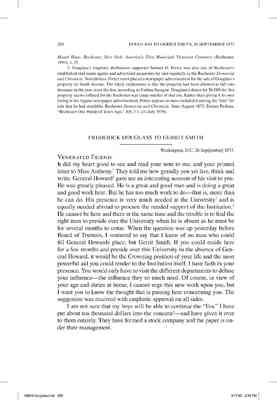Pages
page_0001
FREDERICK DOUGLASS TO SAMUEL D. PORTER
Washington[,] D.C. 18 June 1873.
MY DEAR SIR:
It is now about one year since my house in Rochester was destroyed by fire.1Douglass’s house, which had stood on South Avenue in Rochester for twenty-one years, burned to the ground on 2 June 1872. Although Douglass was in Washington, D.C., at the time, his wife and the family of his son-in-law Nathan Sprague were then residing at the estate. Douglass’s family became aware of the fire in the early hours of the morning, and all managed to escape without harm. Attributed to arson, the fire began in Douglass’s barn and from there spread to his house. Douglass lost twelve volumes of his newspaper, an estimated $7,000 in property, and $11,000 in U.S. bonds that he kept at the estate; only some pieces of furniture, a piano, and a portion of Douglass’s library were saved. Rochester Union and Advertiser, 3 June 1872; NNE, 6 June 1872; Quarles, Frederick Douglass, 268. Until recently I have fondly hoped to rebuild on the place of the old building and to spend there what may remain of life and at last lay down to rest in the beautiful shades of Mt. Hope.2Mount Hope Cemetery, located in Rochester, New York, was established in 1838. With its rural, garden-like design, it is considered the first Victorian-style cemetery in America. Some of the notable people interred there include Susan B. Anthony, women’s rights activist; Myron Holley, abolitionist and proponent of the Erie Canal; and eventually, Frederick Douglass. Richard O. Reisem, Mount Hope, Rochester, New York: America’s First Municipal Victorian Cemetery (Rochester, 1994), 4, 15. I have not parted with this prospect without a struggle, but I have parted with it.
Nathan Sprague, my son in law writes me that it <is> impossible to keep off trespassers—and that the fences and trees are going to ruin—
Now, my purpose in writing to you is, to ask you in the line of your business, to advertise and sell that property for me.3Douglass’s longtime abolitionist supporter Samuel D. Porter was also one of Rochester’s established real estate agents and advertised properties for sale regularly in the Rochester Democrat and Chronicle. Nonetheless, Porter never placed a newspaper advertisement for the sale of Douglass’s property on South Avenue. The likely explanation is that the property had been allowed to fall into disrepair in the year since the fire, according to Nathan Sprague. Douglass’s desire for $6,000 for this property seems inflated for the Rochester real estate market of that era. Rather than giving it its own listing in his regular newspaper advertisement, Porter appears to have included it among the “lots” for sale that he had available. Rochester Democrat and Chronicle, June–August 1873; Dexter Perkins, “Rochester One Hundred Years Ago,” RH, 1: 1–24 (July 1939). I know you will get for it the highest price the property will bring at private sale. The lot contains three acres and is well stocked with choice fruit. I think it ought to bring six thousand dollars. I should want about half in cash and bond and mortgage for the remainder—Running, if you please from two to five years.
By giving your immediate attention to this business, you will much oblige your old friend.
FREDERICK DOUGLASS
ALS: General Correspondence File, reel 2, frames 682–83, FD Papers, DLC.

